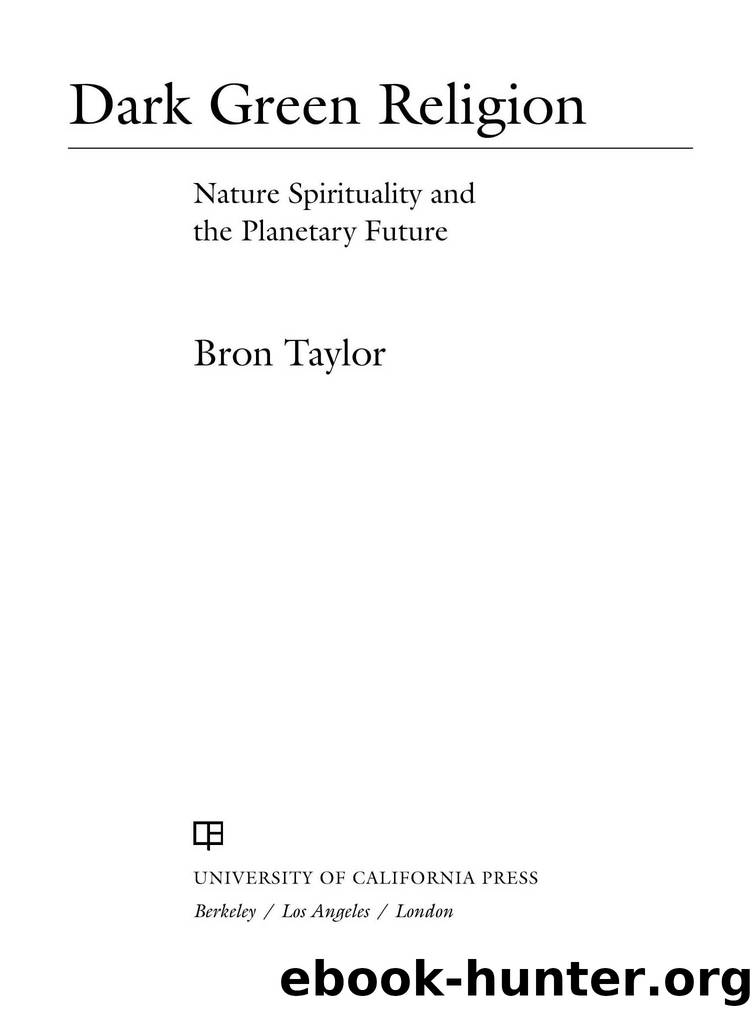Dark Green Religion by Bron Taylor

Author:Bron Taylor
Language: eng
Format: epub
Publisher: University of California Press
Published: 2010-03-03T16:00:00+00:00
Connecting through Interpretation at Museums, Zoos, Aquariums, and Protected Areas
In addition to the already discussed Disney Animal Kingdom Park and various national parks, interpretive displays with conservationist messages are found at many other venues—museums, aquariums, zoos, biosphere reserves, and the like. Some such exhibits have dark green themes. The National Museum of Anthropology in Mexico City, where I spent a full day in January 2008, provides an excellent example of how dark green religious themes are being presented powerfully to the public.
At the museum, the first permanent exhibit introduced the discipline of anthropology. Its most important panels were in both Spanish and English. These were among the most often read panels in the museum, their prominent placement and bilingual display signaling that the curators considered the information in them to be especially important. The first panel explained the age of the earth, the second described evolution and characterized it as a fact. The third panel included these words: “thus, anthropology, through the study of fossil remains and modern primates, can trace the evolutionary relationships, presenting a mirror that reminds us that we are part of the history of the world and the animal kingdom, and not as we had believed, that we were created to have nature at our service.” Note the dark green themes: belonging to nature, we are animals, and a rejection of Western religious cosmogony.
A large adjacent panel described the genus Australopithecus (an early bipedal hominid that scientists believe is a human ancestor). Together these panels expressed clear biocentric and kinship ethics; they also sought to overturn anthropocentric arrogance. The perceptive reader would recognize that (colonial) Abrahamic religions were being criticized for promoting precisely such destructive misperceptions, especially what the panels said was the false earlier view that nature was created only for humans. I was surprised to see all of this stated so forthrightly. Throughout the rest of the museum, other themes typical of dark green religion were expressed, including links between the domestication of plant and animal species, human overpopulation, deforestation, declining ecosystem diversity, declining resilience and agricultural productivity, famine, warfare, and environmental/social collapse. Moreover, although the museum displays forthrightly examined the close links between pre-Christian religions and violence (including human sacrifice), on the whole the connections between religion and nature in pre-Christian Mesoamerica were described in a positive way. Traditional ecological knowledge was explained and its interrelatedness with pagan, nature-related spirituality that yet survives in Mesoamerican indigenous communities was acknowledged and portrayed sympathetically. Also praised was the Paganism still present, in more fragmented form, within the now dominant forms of Christian religion. I concluded that this museum blended professional and up-to-date biocultural understandings, a measure of national pride, and a subtle anticolonial and antitheist attitude. The outcome was a celebration of the spiritual connections human beings once had with nature in Mesoamerica, still have in some measure, and could have again in a more robust way. It might not be going too far to suggest that the museum was a globalized and localized bricolage
Download
This site does not store any files on its server. We only index and link to content provided by other sites. Please contact the content providers to delete copyright contents if any and email us, we'll remove relevant links or contents immediately.
The Lonely City by Olivia Laing(4768)
Animal Frequency by Melissa Alvarez(4424)
All Creatures Great and Small by James Herriot(4267)
Walking by Henry David Thoreau(3921)
Exit West by Mohsin Hamid(3791)
Origin Story: A Big History of Everything by David Christian(3665)
COSMOS by Carl Sagan(3584)
How to Read Water: Clues and Patterns from Puddles to the Sea (Natural Navigation) by Tristan Gooley(3430)
Hedgerow by John Wright(3313)
How to Read Nature by Tristan Gooley(3290)
The Inner Life of Animals by Peter Wohlleben(3282)
How to Do Nothing by Jenny Odell(3263)
Project Animal Farm: An Accidental Journey into the Secret World of Farming and the Truth About Our Food by Sonia Faruqi(3189)
Origin Story by David Christian(3169)
Water by Ian Miller(3155)
A Forest Journey by John Perlin(3042)
The Plant Messiah by Carlos Magdalena(2900)
A Wilder Time by William E. Glassley(2833)
Forests: A Very Short Introduction by Jaboury Ghazoul(2814)
